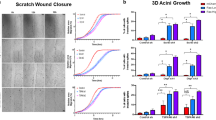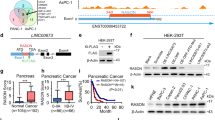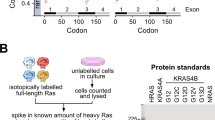Abstract
The RASSF8 gene, which maps close to the KRAS2 gene, contains a RAS-associated domain and encodes a protein that is evolutionarily conserved from fish to humans. Analysis of the RASSF8 transcript revealed a complex expression pattern of 5′-UTR mRNA isoforms in normal lung and in lung adenocarcinomas (ADCAs), with no apparent differences. However, RASSF8 gene transcript levels were ∼seven-fold-lower in lung ADCAs as compared to normal lung tissue. Expression of RASSF8 protein by transfected lung cancer cells led to inhibition of anchorage-independent growth in soft agar in A549 cells and reduction of clonogenic activity in NCI-H520 cells. These results raise the possibility protein encoded by RASSF8 is a novel tumor suppressor for lung cancer.
This is a preview of subscription content, access via your institution
Access options
Subscribe to this journal
Receive 50 print issues and online access
$259.00 per year
only $5.18 per issue
Buy this article
- Purchase on Springer Link
- Instant access to full article PDF
Prices may be subject to local taxes which are calculated during checkout




Similar content being viewed by others
Accession codes
References
Campbell PM, Der CJ . (2004). Semin Cancer Biol 14: 105–114.
Clezardin P . (1998). Cell Mol Life Sci 54: 541–548.
Dammann R, Li C, Yoon JH, Chin PL, Bates S, Pfeifer GP . (2000). Nat Genet 25: 315–319.
De Gregorio L, Manenti G, Incarbone M, Pilotti S, Pastorino U, Pierotti MA et al. (1998). Int J Cancer 79: 269–272.
Debeer P, Schoenmakers EF, Twal WO, Argraves WS, De Smet L, Fryns JP et al. (2002). J Med Genet 39: 98–104.
Ellis CA, Clark G . (2000). Cell Signal 12: 425–434.
Guerois R, Nielsen JE, Serrano L . (2002). J Mol Biol 320: 369–387.
Hesson L, Dallol A, Minna JD, Maher ER, Latif F . (2003). Oncogene 22: 947–954.
Huncharek M, Muscat J, Geschwind JF . (1999). Carcinogenesis 20: 1507–1510.
Jiang Y, Cui L, Yie TA, Rom WN, Cheng H, Tchou-Wong KM . (2001). Oncogene 20: 2254–2263.
Johnson L, Mercer K, Greenbaum D, Bronson RT, Crowley D, Tuveson DA et al. (2001). Nature 410: 1111–1116.
Kiel C, Wohlgemuth S, Rousseau F, Schymkowitz J, Ferkinghoff-Borg J, Wittinghofer F et al. (2005). J Mol Biol 348: 759–775.
Malaney S, Daly RJ . (2001). J Mammary Gland Biol Neoplasia 6: 101–113.
Malumbres M, Barbacid M . (2003). Nat Rev Cancer 3: 459–465.
Mascaux C, Iannino N, Martin B, Paesmans M, Berghmans T, Dusart M et al. (2005). Br J Cancer 92: 131–139.
Nakanishi K, Sakamoto M, Yasuda J, Takamura M, Fujita N, Tsuruo T et al. (2002). Cancer Res 62: 2971–2975.
Nikiforov MA, Hagen K, Ossovskaya VS, Connor TM, Lowe SW, Deichman GI et al. (1996). Oncogene 13: 1709–1719.
Wall JD, Pritchard JK . (2003). Nat Rev Genet 4: 587–597.
Wohlgemuth S, Kiel C, Kramer A, Serrano L, Wittinghofer F, Herrmann C . (2005). J Mol Biol 348: 741–758.
Acknowledgements
We thank Christina Kiel for the in silico analysis of the RAS binding domain of the RASSF8 protein. This work was funded in part by grants from Associazione and Fondazione Italiana Ricerca Cancro (AIRC and FIRC) and from FIRB. GenBank Acc. Numbers: AY665468 to AY665471.
Author information
Authors and Affiliations
Corresponding author
Rights and permissions
About this article
Cite this article
Falvella, F., Manenti, G., Spinola, M. et al. Identification of RASSF8 as a candidate lung tumor suppressor gene. Oncogene 25, 3934–3938 (2006). https://doi.org/10.1038/sj.onc.1209422
Received:
Revised:
Accepted:
Published:
Issue Date:
DOI: https://doi.org/10.1038/sj.onc.1209422
Keywords
This article is cited by
-
Hypoxia-inducible microRNA-224 promotes the cell growth, migration and invasion by directly targeting RASSF8 in gastric cancer
Molecular Cancer (2017)
-
Identification of novel fusion genes in lung cancer using breakpoint assembly of transcriptome sequencing data
Genome Biology (2015)
-
The RASSF gene family members RASSF5, RASSF6 and RASSF7 show frequent DNA methylation in neuroblastoma
Molecular Cancer (2012)
-
RASSF10 Promoter Hypermethylation Is Frequent in Malignant Melanoma of the Skin but Uncommon in Nevus Cell Nevi
Journal of Investigative Dermatology (2012)
-
The RASSF8 candidate tumor suppressor inhibits cell growth and regulates the Wnt and NF-κB signaling pathways
Oncogene (2010)



